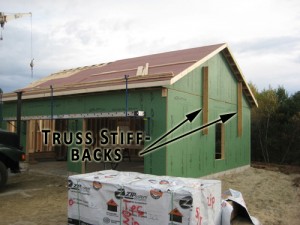Truss Erection Tips


I’ve written previously about Proper Erection of Residential Wood Trusses and Erecting Large Trusses Safely. Wood truss erection can be dangerous and time consuming. However, with a few erection tips you can erect wood trusses safely and efficiently.
Erecting The First Gable Truss


The gable truss is set into place with a crane while men work to securely attach it in two places. One crew attaches the truss to the top of the walls while the other 

Truss Layout


When the delivery truck arrives we unload all of the trusses and separate them into types. This way we can easily erect the trusses in the order that makes the most sense for the layout and safety. For this particular house we erected the garage trusses the day before. By installing them the prior day and sheathing the garage roof we were able to use that roof section as a stiff bracing point.
We typically like to have one guy work with the crane operator sorting through the trusses and hooking them up to the crane.
We then have 4 or 5 men working as a team setting the trusses. Typically 3 or 4 men will be “up” in the trusses nailing them to the walls and installing bracing. One additional man stays down below to hand up bracing members, nails, levels and any other equipment they might need. The person on the ground also acts as the crane signal person to help the crane operator position the trusses safely.
Time Savers
Another big time saver is building the gable rakes ahead of time. As you can see in the adjacent photo the crew has attached the pre-built rakes to the gable truss before it’s lifted into place by the crane. This is a huge time saver and also eliminates men working really high up in the air on ladders trying to install these heavy rake frames.
Truss Erection Summary
The most important truss erection tip I can give is to take your time and work safely. Add more bracing then the plans call for and if something doesn’t look right stop and ask questions. It only takes a couple minutes to have a horrible accident that could injure or kill someone. Wood trusses are definitely the quickest and most cost e
ffective method of framing a roof when done properly.
Recent Posts
Framing Stick Nailer vs Coil Nailer
Which is Better a Stick Nailer or Coil Nailer? Framers have many choices in nailers…
How Many Roofing Nails Per Square of Shingles
Estimating How Many Nails for a New Roof When it comes to estimating materials for…
Composite / PVC Decking – Layout Tips & Advice
Composite / PVC Decking Layout Tips and Advice Composite and PVC decking have really changed…
Benefits of an ERV System (Energy Recovery Ventilator)
Benefits of ERV Systems (Energy Recovery Ventilator) If you're building a new home or doing…
Vermiculite Attic Insulation Abatement
Vermiculite Attic Insulation If your home was built before 1990 there is a chance it…
Nuisance Tripping of AFCI (Arc Fault) Circuit Breakers
Arc Fault (AFCI) Circuit Breakers Tripping Often An arc-fault circuit interrupter (AFCI) or arc-fault detection…



View Comments
We really enjoy what you write about here. I try and read your blog every day so keep up the good writing!
Looks good, that's how I would like to frame my roof. Looks a good job.
Great post! I agree that any work you can do on the ground is better work. Once the truss is on the roof it is much harder to work on it. So, I don't know why anyone would want to add gable rakes after the trusses are on the roof.
Thanks for taking the time to explain some of these tips for putting up trusses. My wife and I are just breaking ground on our new house. I didn't realize that putting up the first truss is so dangerous. I guess that is why it is good to have multiple trained men working on a project like this. Thanks for the info!
I like your style. But a good mention would ne a tag line. The ground guy holding the rope to keep the truss straight. In the direction you want it to go.
Also starting with the common trusses if applicable. It is easier to brace them fist then set and plumb the gable end